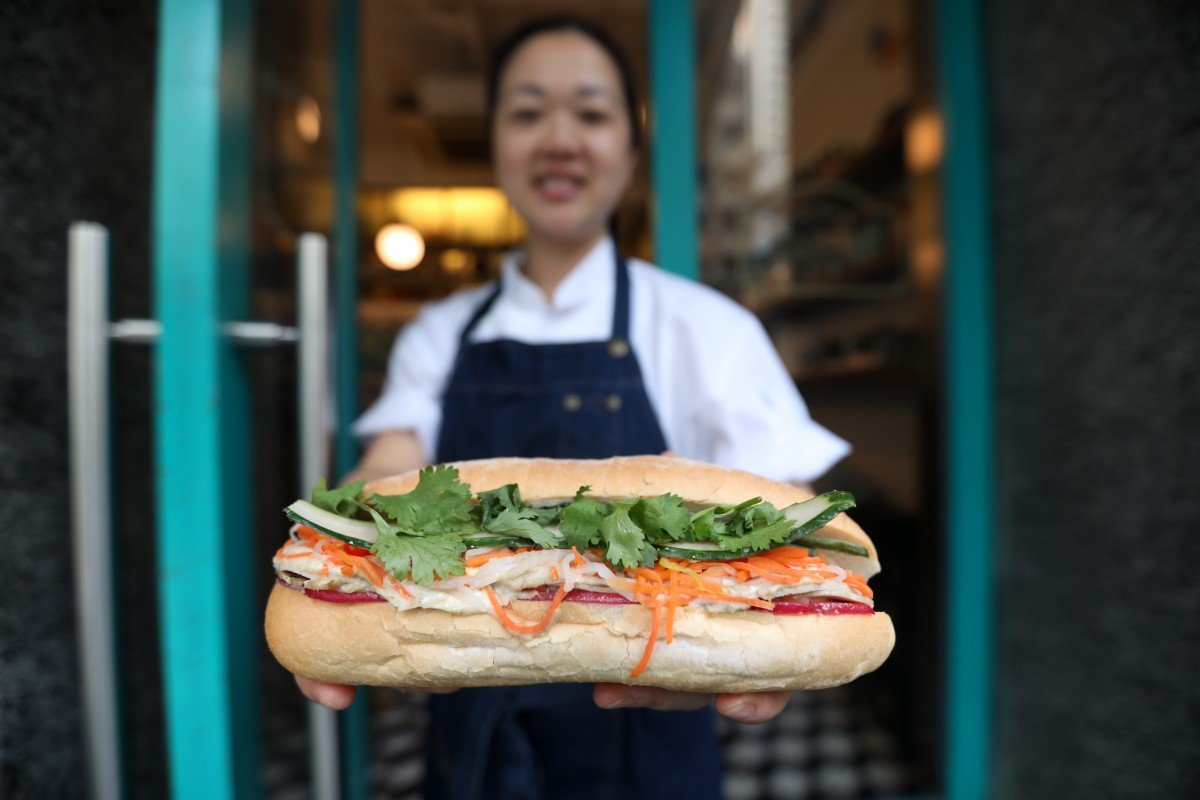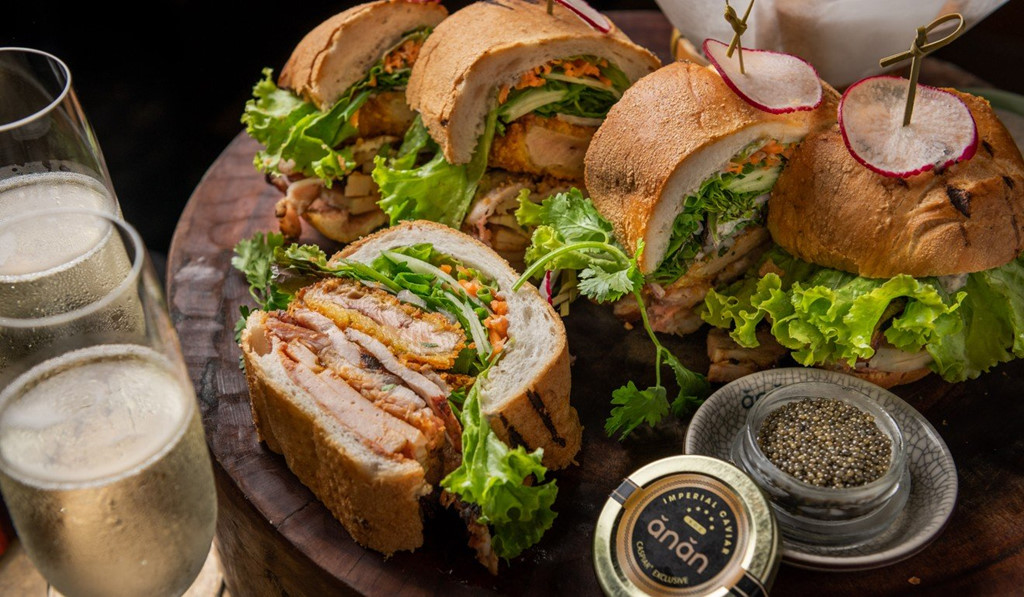Story of the banh mi: Vietnam’s super sandwich that took on the world

Le Petit Saigon chef Theign Yie Phan with a pork banh mi. PHOTO: South China Morning Post
"It is a good between-service snack. I eat one every other day. It is definitely not something you get sick of," she says with a laugh, as she stands in front of an array of colourful ingredients ready to be stuffed into a crusty baguette at Le Petit Saigon in Wan Chai.
Along with pho, the noodle soup, banh mi is one of Vietnam's most famous culinary exports - a French-style bread filled with rich meats and zingy, fresh vegetables and herbs.
"As a sandwich it is well balanced in flavours and textures. There's the crusty warm bread, the richness of the flavours of the meat, and then the tartness and sourness from the pickles," says Phan, who is also the head chef of next-door sister restaurant, Le Garcon Saigon.
Cutting open a baguette, Phan begins layering it with thinly sliced pork belly, terrine and Vietnamese sausage, topped off with chicken liver pate and house-made mayonnaise. Next she balances that with slices of fresh cucumber, pickled vegetables, Maggi sauce, coriander, spring onion and chilli - "for punch".
Phan is not alone in her love of the sandwich. Banh mi has gone from humble beginnings on the streets of Saigon to become a global sensation - mirroring the history of modern Vietnam. So how did a country in Southeast Asia - known for rice and noodle dishes - originate such a Western speciality as a sandwich?
Banh mi date back 130 years to when France colonised Vietnam from the 1880s to 1954. During that period the French forced the Vietnamese to work in slave-like conditions on plantations growing opium and rubber, taxing them heavily.
Culturally the French introduced Catholicism, its national language and architecture. And, of course, food.
Chef Peter Cuong Franklin has researched French cuisine's influence in Vietnam. He was born in Da Lat, in southern Vietnam, and during the tumult of the Vietnam war (1955-75) was separated from his family and adopted in the United States.
In 1994, he relocated to Hong Kong to work as an investment banker, and later headed to the Thai capital, Bangkok, to attend the Cordon Bleu culinary school. After returning to Hong Kong he opened his own Vietnamese-themed restaurants, Chom Chom, and Viet Kitchen. Then in 2017 he moved to Ho Chi Minh City (formerly Saigon) to open Anan Saigon.
"When the French colonised Vietnam, they needed to eat their own food. So they brought things like wheat to make bread, cheese, coffee, and other products that they would consume every day," Franklin says.
The Vietnamese were gradually introduced to these French foods, he says, though they were expensive back then. Eventually wheat, and the technique for making baguettes, were imported, and the locals - in particular the ethnic Chinese-Vietnamese - learned how to make bread.
"They [the Chinese] were hired as chefs and cooked for the French," Franklin explains. Over time, they came to see that what they were preparing was no longer for the French, but for the locals. "They would modify the bread with more yeast and water to make it lighter, for Vietnamese tastes."
The French typically ate baguettes spread with chicken liver or goose liver pate, which the Vietnamese found too rich. So they developed their own version.
"The Vietnamese used local pork liver, which is cheaper and easier to make. Most of the time the French ate baguettes with some butter and maybe some mustard [to spread on the charcuterie]," he says.
But in the 1950s, "the Vietnamese came up with the idea of putting these things together into a simple sandwich to be consumed by a lot of people. So I think that's the early form of the sandwich".
The flavours of the modern banh mi vary by region in Vietnam. In Hanoi in the north, the fillings are more simple than the "original" found in Ho Chi Minh City in the south, and include high-quality cold cuts. In the central coastal city of Hoi An, the meat used is served warm.
 |
Banh mi sold by a street vendor in Vietnam. Photo: South China Morning Post
Despite its humble roots, banh mi went on to explode in popularity around the world, especially in countries such as Australia and the United States.
Nowadays, there are more than 1.3 million Vietnamese immigrants living in the US, and their traditional food has been widely embraced by the American mainstream.
"The US is a hub of pop culture, and over the years TV food shows, travel shows, Anthony Bourdain, food blogging and social media" have helped introduce people in the West to this quintessential fusion Vietnamese dish, says Phan.
Despite being Southeast Asian - she was born in Malaysia and grew up in Singapore - it was only when she studied in the US that she was introduced to Vietnamese street food.
"In America, every university town has a street with lots of food carts, and one of these stores always serves [banh mi]. I remember during the cold winters in Wisconsin, I would walk past and grab a banh mi from one of these stores and walk to class," she recalls fondly.
Phan believes the wider American population embraced banh mi when it was introduced by Vietnamese immigrants because the ingredients used were "familiar" to the American palate.
"The bread, familiar; the meat, familiar; the vegetables and pickles, familiar. So people were more inclined to try it and maybe that's why it exploded," she says. "Everyone loves a good sandwich. And in every culture [with bread] there is some sort of sandwich. So banh mi is very accessible culturally, so that's why it has become so popular worldwide."
Given that this portable snack is available at street stalls in Vietnam for US$1, it's perhaps not surprising that Franklin created a stir when he unveiled the US$100 banh mi two years ago at his Anan Saigon restaurant.
 |
US$100 banh mi at Anan Saigon. Photo: South China Morning Post
"Part of my mission is to elevate Vietnamese cuisine to a higher level, to get people to rethink what Vietnamese food can be. And banh mi is very popular around the world because it's healthy and light, and it is flavourful. But one problem we have with the cuisine is that people think it's great but they think it should be cheap as well … so what I've done is done something crazy."
The Anan Saigon banh mi is replete with truffle mayonnaise, pate, sous vide pork chop, foie gras, coriander, cucumber, basil and mint. If that's not enough, there are also sweet potato fries dipped in caviar on the side. He says there are curious gastronomes willing to dig deep into their pockets to see what it tastes like.
"We have some detractors who think like things like the banh mi or pho, or food in general, should not change. But I'm a believer that food can and should change with the times. You look at Vietnam, it's modernising very quickly, and I can see change in the past two years I've been here."
Back in Hong Kong, Phan at Le Petit Saigon sells about 90 banh mi a day to hungry customers. There are several varieties to choose from, including the traditional banh mi thit (pork), banh mi ga (chicken) and banh mi chay (tofu).
But Phan is not afraid to get creative with her menu. Each month she invites chefs from various restaurants in the group to contribute their own version of banh mi to the menu. This month, Michelin-star chef Palash Mitra from The New Punjab Club created a mouthwatering tandoori chicken tikka banh mi.
But she says the best selling is still the traditional Saigon pork banh mi.
Some tastes change, while others stay the same.
South China Morning Post
Recommended
 Handbook
Handbook
Vietnam Moves Up 8 Places In World Happiness Index
 Handbook
Handbook
Travelling Vietnam Through French Artist's Children Book
 Multimedia
Multimedia
Vietnamese Turmeric Fish among Best Asian Dishes: TasteAtlas
 Handbook
Handbook
From Lost to Found: German Tourist Thanks Vietnamese Police for Returning His Bag
Popular article
 Handbook
Handbook
Prediction and Resolution for the Disasters of Humanity
 Handbook
Handbook
16 French Films To Be Shown For Free During Tet Holiday In Vietnam
 Handbook
Handbook
Unique Cultural and Religious Activities to Welcome Year of the Snake
 Handbook
Handbook



